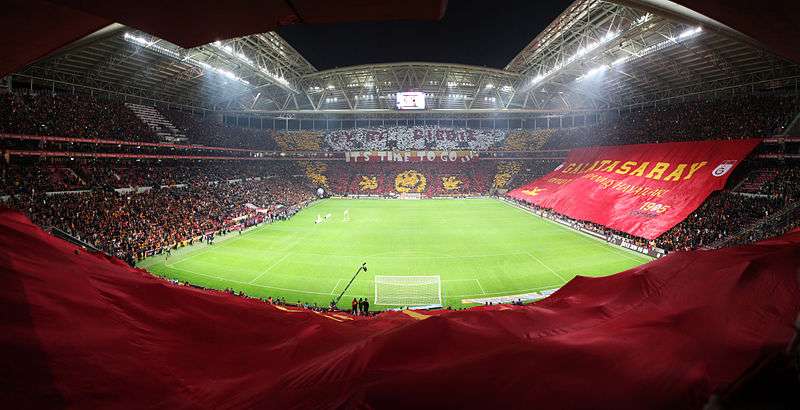Türk Telekom Stadium
Türk Telekom Stadium (officially known as the Ali Sami Yen Spor Kompleksi – Türk Telekom Stadyumu) is a football stadium serving as the home ground of the Süper Lig club Galatasaray S.K.. It is located in the Seyrantepe quarter of the Sarıyer district,[10] on the European side of Istanbul, Turkey. The all-seater stadium has the capacity to host 52,223[11] spectators during football games. The stadium is part of the Ali Sami Yen Sports Complex.
Arena, Seyrantepe | |
 | |
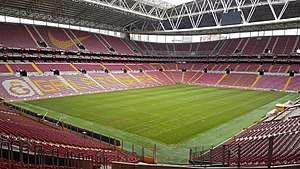 UEFA | |
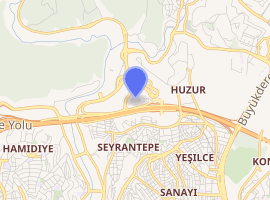
| |
| Full name | Ali Sami Yen Spor Kompleksi Türk Telekom Stadı |
|---|---|
| Former names | Türk Telekom Arena (2011–2017) |
| Location | Sarıyer, Istanbul, Turkey |
| Coordinates | 41°6′10.33″N 28°59′25.51″E |
| Public transit | |
| Owner | Galatasaray SK |
| Operator | Galatasaray SK |
| Executive suites | 198[1] |
| Capacity | 52,652 (2011–2013) 52,223 (all-seater)[2] |
| Record attendance | 52,044 (Galatasaray-Real Madrid, 9 April 2013) |
| Field size | 105 m × 68 m (115 yd × 74 yd) |
| Acreage | 190,000 m² |
| Surface | Grass (2011–2018) SISGrass |
| Scoreboard | 2 x 77,41m²[3] |
| Construction | |
| Broke ground | 13 December 2007 |
| Built | 2007–2011 |
| Opened | 15 January 2011 |
| Construction cost | $250 million ($284 million in 2019 dollars[4])[5][6] |
| Architect | 'asp' architekten Stuttgart[7] |
| Structural engineer | İz Mühendislik Yüksel Proje Schlaich Bergermann & Partner[8] |
| Services engineer | OBERMEYER: Planungsgesellschaft[9] |
| Main contractors | Varyap-Uzunlar |
| Tenants | |
| Galatasaray SK (2011–present) | |
| Website | |
| www | |
Türk Telekom Stadium was the first stadium in Turkey that met the UEFA Euro 2016 requirements during the country's bid to host the European Championship.[12] In 2011, Türk Telekom Stadium was one of the six nominees for the Venue of the Year and New Venue categories of the Stadium Business Awards.[13] Galatasaray SK won the Süper Lig in the first season at Türk Telekom Stadium. Türk Telekom Stadium and Galatasaray SK were mentioned in the first chapter of Tom Clancy's 2012 novel Threat Vector.[14]
History
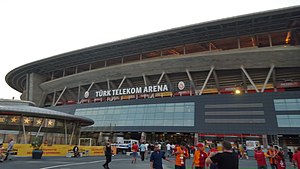
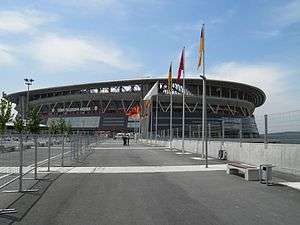
Football (soccer) was first played in Istanbul by some British players in a field known as Papazın Çayırı ("Priest’s Field") in the area that is now the site of Fenerbahçe's Şükrü Saracoğlu Stadium. With the opening of the Taksim Stadium in 1921, it was this new stadium that became the new football headquarters. In the urban development of 1939, the military barracks in which the Taksim Stadium was located was demolished in 1940. The stadium was thus lost. In this period, Fenerbahçe bought the land encompassing Papazın Çayırı and built the Fenerbahçe Stadium, while the Beşiktaş Club moved into the Şeref Stadium, located in the area where today's Çırağan Palace Hotel stands. It was Galatasaray that experienced the biggest problem with the use of a stadium in that period.
The first steps to overcome this problem were taken in the initial years of the 1930s. The first initiative to acquire a plot of land for Galatasaray was in 1933, when the then president of the club Ali Haydar Barşal showed an interest in a mulberry orchard in Mecidiyeköy. In the period between 1933 and 1935, negotiations with the government resulted in the allocation of a plot of land outside of the city limits in Mecidiye Köyü (Mecidiye Village, present-day Mecidiyeköy quarter of the Şişli district) for a stadium to be built for Galatasaray. Excavations for the construction began in 1936. The President of the Turkish Sports Organization at the time, Adnan Menderes, provided financial assistance for the project. However, the efforts were left in the excavation stage.
In 1940, the matter of the stadium came up again under the presidency of Tevfik Ali Çınar. The same plot of land was leased to Galatasaray for a term of 30 years at a symbolic yearly rental fee of 1 lira. Galatasaray thus acquired the right to the use of the land. In leasing the land, Galatasaray committed to building a modern stadium as well as a bicycle velodrome. The construction could not start, however, due to limited funds and the general atmosphere of the war years. In 1943, Osman Dardağan led an initiative to build a modest stadium that would answer the immediate need. In the atmosphere of war, only a small open tribune was allowed in the stadium, which was set on a field of earth and inaugurated under the presidency of Muslihittin Peykoğlu in 1945. However, its distance from the city center in those days, its inaccessibility by public transportation, and the rough winds that characterized the district were factors that contributed to a long period in which the stadium would lay idle and football games never took place.
When the İnönü Stadium in the center of the city was opened in that period, Galatasaray abandoned the stadium building project in Mecidiyeköy, putting the project aside before fruition. In 1955, 30 more years were added to the right of utilization agreement, which at the time had 22 years to go, extending the terms until 2007. When the Club failed to undertake the building of the Stadium, the project was taken on by the Physical Education General Directorate. The construction started in 1959. In 1961, during the presidency of Refik Selimoğlu, a new agreement was signed with the Physical Education General Directorate whereby the utilization rights of the newly completed stadium were explicitly given to Galatasaray.
The stadium was opened on an eventful December 20, 1964. In the midst of the extreme crowds present, panic broke out, resulting in the death of one spectator and the injury of 80 others. In 1965, the stadium was illuminated for the first time. Despite this, however, not many night games were played. At the beginning of the 1970s, the stadium was abandoned for another period during which the İnönü Stadium began to be used again. In the 1970s, the stadium was mostly used by Galatasaray for training sessions. In those years, it remained in a squalid state of neglect.
In 1981, grass was planted on the field and the stadium was opened again. The lighting system was renewed in 1993, after which night games began to be played once more. In the same year, the system of combined tickets was initiated in Turkey at the Ali Sami Yen Stadium. Also in the same year, the stadium was furnished with seats to replace the old benches. The capacity of the stadium was thus reduced from 35,000 to an all-seater capacity of 22,000. In 1997, the Galatasaray administration assigned a Canadian architectural firm for the task of designing Turkey's first multi-function, modern stadium to be built in place of the Ali Sami Yen Stadium, which was planned to be torn down.
On 10 December 2013, a UEFA Champions League match between Galatasaray and Juventus had to be abandoned due to heavy snow in the 32nd minute with the score 0–0, the remaining minutes of the match were played the next day.[15]
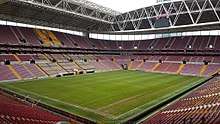
New stadium projects
Faruk Süren project
The new stadium project was launched in 1998 and it attracted wide interest. During the promotion of the modern loge system, the entire loge section was sold at a symbolical fee. The proposed capacity was 40,484. However, the mayor and the state did not allow of a stadium to be built.
Mehmet Cansun project
Over the period of 2001–2002, a revision was made in the project with an eye toward reducing the amount needed for financing but this time, although costs were brought down, the economic crisis of 2001 stood in the way of overcoming the financial issue. Capacity was reduced to 35,000.
Özhan Canaydın: Back to Süren's project
In the 2002–04 season, the old project came up again but was abandoned in favor of building a new and modern stadium. Again, financing needs could not be met. After a general renovation that took place in the 2004–05 season, the club returned to the Ali Sami Yen Stadium. Following the 1999 İzmit earthquake, the old Open Tribune was demolished and replaced in the 2005–2006 season for safety reasons.
Özhan Canaydın: Leaving Mecidiyeköy, new home in Aslantepe
Because Mecidiyeköy was now a part of the city center, state authorities objected to the expansion of the stadium in this district. A new piece of land was suggested to Galatasaray as an alternative.
The search for financing for the new stadium that would be built on this new plot continued over the period of 2004–07. In 2007, discussions with state authorities regarding the erection of a new Galatasaray stadium in Aslantepe yielded positive results. It was decided that the new stadium would be built within two years on the new land plot that would be transferred to Galatasaray, in exchange for the club's property in Mecidiyeköy on which the Ali Sami Yen Stadium stood.
A dream comes true
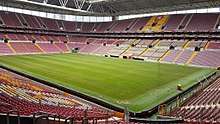
At the end of 2007, ten years after the initial announcement of the project in 1997, the groundbreaking for the new stadium was carried out (December 13, 2007) at a ceremony attended by state officials. The old project was put aside and a new project was contracted to Mete Arat in Germany. 2008, In Galatasaray's last year at the Ali Sami Yen Stadium, the Lower Closed Tribune was renovated in line with UEFA standards. 2009, The construction of the new stadium, the Türk Telekom Stadium, gained speed when the contracting company was changed. 2010, It was announced that the official opening of the new stadium would take place on January 15, 2011, with Prime Minister Recep Tayyip Erdoğan presiding. But in the opening ceremony, he was protested by spectators of Galatasaray.
Project overview
| Project | Year | Location | Capacity | Suites | Architect | Cost | Info |
|---|---|---|---|---|---|---|---|
| Faruk Süren project | 1997–2001 | Mecidiyeköy | 40,482 | 125+72 boxes without outside seating | BBB Architects | $118.5 million ($186 million in 2019 dollars[4]) |
2 different roof and stand styles. A Mall next to the stadium was also planned |
| Mehmet Cansun project | 2001 | Mecidiyeköy | 35,000 | 132 | GS member Architecture group* | $35 million ($50.5 million in 2019 dollars[4]) |
*Emre Arolat, Doğan Hasol, Tabanlioglu Architects, Eren Talu, DB Architects[16] |
| Özhan Canaydın:Back to Süren's project | 2002–2005 | Mecidiyeköy | 40,482 | 125+72 boxes without outside seating | BBB Architects | $90 million ($125 million in 2019 dollars[4]) |
Same project, just lower cost |
| Eren Talu bidding project | 2007 | Aslantepe | 52,000 | 150 | Populous | n/a | Eren Talu's project for the bid. GS logo as a ramp |
| Özhan Canaydın project | 2007 | Aslantepe | 52,652 | 157 | asp Stuttgart | $250 million ($284 million in 2019 dollars[4]) |
Built |
Aslantepe
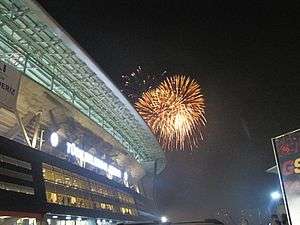
In recent years, numerous proposals had been put forward to demolish the current stadium and build a new, larger one on the same location, but this was impossible due to the lack of space. Finally, the club's stadium, Ali Sami Yen Stadium, was now going to be replaced with a new stadium near Maslak financial district. The former name of the district, Seyrantepe, was changed to Aslantepe (Lion Hill) after Galatasaray purchased the land; Aslan ("Lion") being Galatasaray's symbol. The idea was to realize a stadium on the model of Arena AufSchalke in Gelsenkirchen, Germany. The stadium will feature a retractable roof—the first of its kind in Turkey.
Auction process
Galatasaray have been in cooperation with TOKİ (one of the biggest construction organizations of Turkey, budgeted by the Turkish government).
Among the four companies that tendered proposals, the best offer was put forward by the Eren Talu Architecture – ALKE Partnership. The contract for the tender held for the construction of Galatasaray's new stadium was signed between TOKİ and Eren Talu-ALKE consortium on 23 October 2007.[17] The contract of the tender was realized by TOKİ and came to be known as the "Aslantepe Tender", covering the construction of a multi-purpose sports complex with 52,652 spectator capacity on Aslantepe (formerly known as Seyrantepe) premises in return for building "Urban Social Infrastructure Areas" on 34.640 sq meters of land on which the present Ali Sami Yen Stadium is located.
There is a set period of 720 days for the construction of the stadium that will be built on the Aslantepe (formerly known as Seyrantepe) premises. The box count is 198 Part of the catering areas Turk Telekom Stadium consists of, is a VIP lounge room, VIP Market Area, Premium Food Court, Galatasaray Museum, Galatasaray Mega Store, 11 Galatasaray Store and a VIP restaurant. The modern stadium, contains five top and four underground levels.[18]
Partnership
Once the Eren Talu-ALKE consortium had won the tender for the stadium project, they proceeded to find a foreign technical partner with previous experience in sports-construction related projects. They were introduced to the Abu Dhabi Group and Al Zarooni Group, both headquartered in the UAE. Abu Dhabi Group (also known as Dhabi Group), the largest foreign investor group in Pakistan, and the Al Zarooni Group are investors in the gigantic 5.5 million sq.m. Dubai Sports City project that is currently under construction in Dubai. The Chairman of Abu Dhabi Group is His Highness Sheikh Nahayan Mabarak Al Nahayan, who is also the Federal Minister for Higher Education & Scientific Research of the UAE and a very important member of Abu Dhabi's Ruling Family. The Dhabi-Zarooni consortium acquired 51% of the Eren Talu-ALKE consortium's shares to co-invest a total of $650 million with them in the Aslantepe (New Stadium) and Mecidiyeköy (Old Stadium) projects.
Stating that a total amount of $650 million will be invested for the entire project, Eren Talu said, "$170 million of this amount will be spent for the stadium, in addition to $180 million which is the guaranteed TOKİ share, a $50 million additional TOKİ share and the remaining $250 million+ to be invested in the mixed-use development project intended in Mecidiyeköy". Talu added that TOKİ's participation in the project provides great advantage for the partnership and continued, “our partners had confidence in the public benefit of the project and decided to join within a short period of just 2 months". Talu said they have already spent $37 million so far in order to construct up to the current level of the stadium. Stating that the stadium is to be delivered on time on 29 October 2010, Talu said, “We are casting 1,500 cubic meters of concrete every day. We have driven 4,500 meters of piles into the ground. A labour force of above 350 workers is busy at the construction site 24 hours a day. The stadium is going to be so strong that it may even be used as a catastrophe relief center if required."
Talu said the project being contemplated on the land in Mecidiyeköy in lieu of the old Ali Sami Yen Stadium will be initiated in June 2009, and added, “the mixed-use development project that we are going to build on land measuring 34,600 square meters will include apartments, a large shopping center, offices and a five-star hotel. A total of $650 million will be invested in these two projects, and in return, we expect an income of about $1.3 billion when the Mecidiyeköy mixed-use complex is completed. Therefore, this is a highly profitable venture."
The total stadium construction is expected to cost around US$191 million, not including the US$145+ million which will be spend on upgrading the nearby infrastructure.
The construction of the stadium stopped twice a time. When Talu had financial problems once again, TOKİ cancelled the process in July 2009.[19] After termination of TOKİ-Talu agreement, TOKİ announced a new auction. Varyap-Uzunlar consortium won the auction[20] and construction restarted in September 2009. Galatasaray and TOKİ had an agreement that the stadium would be opened without retractable roofs which will be installed at the end of the season.[21]
Groundbreaking ceremony
As of 13 December 2007, the construction has officially started after a glitzy reception where the club's board, some players, the minister of sports for Turkey and many other ministers attended. In the ceremony, then President Özhan Canaydın stated, in summary: "The Turkish World of Sports will gain another big facility with the Ali Sami Yen Sports Complex and we've gathered here to celebrate its groundbreaking ceremony. This work, which will be a value add to Istanbul and Turkey along with Turkish Sports, will also serve as an honorable monument that will signify the advanced position Turkish Sports has achieved and the phases it has passed through."[22]
Name
The naming rights were sold to Türk Telekom for a period of 10 years for US$10.25 million a year. The stadium has officially replaced the Ali Sami Yen Stadium at the middle of the 2010–2011 Süper Lig season, under the name of Türk Telekom Arena. North tribune's name of this stadium were sold to Pegasus Airlines for €4 million a year. The contract ended in October 2013.[23][24] The naming rights of the first tier of the east tribune of Türk Telekom Stadium were also sold to Ülker for $2 million a year and will be named as Ülker Family Tribune.[25] All 198 suites' and 4,844 VIP seats' naming rights were sold to Denizbank for three years.[26]
On 18 December 2012 Galatasaray SK and Opel signed a 2.5-year contract for the naming rights of the Southstand.[27][28] The Club will receive €1.5 million per year (€3.75 million in total).[29][30] On 24 September 2013 Galatasaray SK and Odeabank signed a five-year contract (€590,000 a year) for naming rights to the Northstand.[31][32]
| Stand | Sponsor | Duration | € M/year | Total € M |
|---|---|---|---|---|
| Stadium | Türk Telekom | 10 years (2011–2021) | 7.5 | 75 |
| North | Pegasus Airlines | 2 years (2011–2013) | 4 | 8 |
| Odeabank | 5 years (2013–2018) | 0.59 | 2.95 | |
| South | Opel | 2.5 years (2012–2015) | 1.5 | 3.75 |
| MNG Kargo | 2 years (2015–2017) | ? | ? | |
| 1st tier East | Ülker | 2 years (2011–2013) | 2 | 4 |
Facts
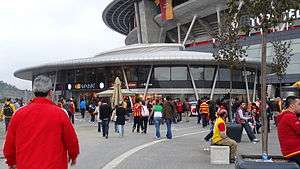
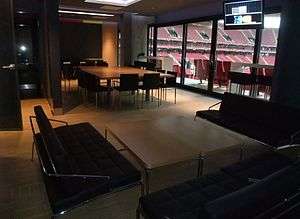
Dimensions
- Stadium: 195,000 m² – 228m x 190m x 70m
- Playing level: 120 m x 83 m
- Gross grass area: 111 m x 72 m
- Playing field: 105 m x 68 m
Capacity
- West Stand: 10,713
- 1st tier: 5,525
- 1st suit level: 399
- 2nd suit level: 266
- 2nd tier: 4,523
- East Stand: 11,425
- 1st tier: 5,751
- 1st suit level: 399
- 2nd suit level: 266
- 2nd tier: 5,009
- Opel / South Stand: 15,246
- 1st tier: 8,209
- 1st suit level: (no suites existing)
- 2nd suit level: 484
- 2nd tier: 6,553
- Odeabank / North Stand: 15,268
- 1st tier: 8,028
- 1st suit level: (no suites existing)
- 2nd suit level: 622
- 2nd tier: 6,618
Stands
- 1st Tier: 19.93° – 29.54° (average 23.96°)
- 2nd Tier: 34.61° – 35.474° (average 35.10°)
- Distance West/East stand to the pitch: 6.2 m
- Distance North/South stand to the pitch: 8.2 m
- First row is 6 cm above pitch level
- Highest row at West/East stand: 36.07 m
- Highest row at North/South: 34.93 m
- 1st tier: 37 rows
- Suit balcony: 3 rows
- 2nd tier: 20–27 rows
Suites[33]
- South stand: 65 suites
- West stand: 49 suites
- East stand: 52 suites
- North stand: 32 suites
- Total: 198 suites
- 6.321 seats
- capacity: 6 – 27 person
Construction
Additions
Concerts
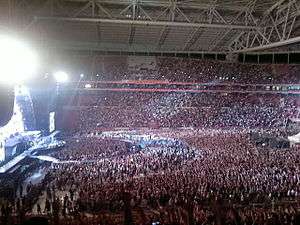
The stadium can also be turned into a concert arena with a capacity for over 70,000 people. The first band to play at Türk Telekom Stadium was Bon Jovi on 8 July 2011.[37][38] The second singer at the stadium was Madonna, who performed on 7 June 2012 as part of her MDNA Tour. She played in front of 47,789 fans.[39]
Surroundings

Aslanlı Yol
From the Seyrantepe Metro Station just east of the stadium, visitors approach the stadium through a road called Aslanlı Yol, which was designed to disentangle and guide them to the entrance. It is 200 meters long and 45 meters wide. Ticket sales, Simit Sarayı Restaurant and Yüzevler Restaurant are also located at the Aslanlı Yol.
Aslantepe GSStore
On 7 February 2012 a new GS Store opened next to the stadium.[40] It has got a similar architecture and was designed by Galatasaray SK project coordinator Coşkun Peküstün and the architect Ayşegül Uslu.[40][41] it is built on a 950 m² area and the floor area is 1,650 m². It has got two floor, while the first floor is used for the retail and the second the Ülker Fan Zone.
Transportation
Public transport
Türk Telekom Stadium is served by a number of bus routes and the shuttle line of Metro M2, which runs from the Sanayi Mahallesi Station to Seyrantepe at the stadium.[42]
| Service/Operator | Station/Wharf | Line |
|---|---|---|
| Train | Seyrantepe Metro station | |
Car
The stadium is located next to the Otoyol 2 motorway. There are four four-story parking garages with 3,225 (3,025 covered and 200 open) parking places. In addition, there are also 28 places available for buses at the west entrance.
Payment methods
GS Bonus Card
GS Bonus Card is the stadium card of Galatasaray SK which can also be used as a credit card. Unified RFID cards are used as season tickets at Türk Telekom Stadium. The card can be used for all services at the stadium.[43][44][45]
fastPay
On March 12, 2019, Galatasaray and DenizBank started an important cooperation which will lay the foundation of the cash-free payment period at Ali Sami Yen Sports Complex Türk Telekom Stadium for the first time in Turkey. Accordingly, the fans will be able to make payment through fastPay, the first digital wallet of Turkey, while shopping at the stadium, the stores and the snack bars around the stadium and at the GS Store, easily and safely without having to pay any cash.[46]
Records
Attendance
- The highest attendance recorded at Türk Telekom Stadium was 52,044 for an UEFA Champions League quarter-final match between Galatasaray and Real Madrid CF on 9 April 2013.
- The highest attendance for a Süper Lig match is 51,983, between Galatasaray SK and Trabzonspor on 18 May 2013.
- The highest attendance for a non-competitive game is 40,000, set on 15 January 2011 for a pre-season testimonial between Galatasaray and AFC Ajax.
- The highest attendance for a Türkiye Kupası match is 31,930, set on 2 March 2011, when Galatasaray played against Gaziantepspor.
- The highest attendance for a national team match is 49,532. Set on 7 October 2011, when Turkey played against Germany.
- The highest attendance for a concert is 47,789. Set on 7 June 2012, when Madonna performed a concert as part of her MDNA Tour.
List
| Rank | Attendance | Date | Game |
|---|---|---|---|
| 1 | 52,044 | 9 April 2013 | Galatasaray SK – Real Madrid CF |
| 2 | 51,983 | 18 May 2013 | Galatasaray SK – Trabzonspor |
| 3 | 51,793 | 5 May 2013 | Galatasaray SK – Sivasspor |
| 4 | 51,663 | 28 September 2019 | Galatasaray SK – Fenerbahçe SK |
| 5 | 51,578 | 5 May 2019 | Galatasaray SK – Beşiktaş J.K |
| 6 | 51,567 | 22 April 2012 | Galatasaray SK – Fenerbahçe SK |
| 7 | 51,393 | 18 March 2011 | Galatasaray SK – Fenerbahçe SK |
| 8 | 51,350 | 6 April 2014 | Galatasaray SK – Fenerbahçe SK |
| 9 | 51,311 | 16 December 2012 | Galatasaray SK – Fenerbahçe SK |
| 10 | 51,278 | 16 November 2012 | Galatasaray SK – Manchester United FC |
Loudest crowd
On March 18, 2011, the Türk Telekom Stadium recorded 131.76 decibels which was considered to be the world record for "loudest crowd roar at a sport stadium" in Guinness World Records[47][48][49] The record has since then been raised by NFL American football games starting with September 15, 2013 at CenturyLink Field in a Seattle Seahawks game that reached 136.6 decibels;[50] on October 13, 2013 at Arrowhead Stadium in a Kansas City Chiefs game that reached 137.5 dB,;[51] again at CenturyLink Field on December 2, 2013, with 137.6 decibels;[52] and most recently reclaimed by Arrowhead Stadium on September 29, 2014 in a game that reached 142.2 dB.[53][54]
Matches
Turkish National Team
Türk Telekom Stadium is one of the main home stadiums of the Turkish national Football team
| Date | Time (CEST) | Team #1 | Res. | Team #2 | Round | Attendance |
|---|---|---|---|---|---|---|
| 10 August 2011 | 20.30 | 3–0 | Friendly | 25,000[55] | ||
| 2 September 2011 | 19.00 | 2–1 | Euro 2012 qualifying | 47,756[56] | ||
| 7 October 2011 | 20.30 | 1–3 | Euro 2012 qualifying | 49,532[57] | ||
| 11 October 2011 | 19.00 | 1–0 | Euro 2012 qualifying | 32,174[58] | ||
| 11 November 2011 | 20.05 | 0–3 | Euro 2012 qualifying | 42,863[59] | ||
| 14 November 2012 | 20.30 | 1–1 | Friendly | 30,000[60] | ||
| 17 November 2014 | 20.45 | 3–1 | Euro 2016 qualifying | 27,549[61] | ||
| 14 November 2019 | 18.00 | 0–0 | Euro 2020 qualifying | 48,329[62] |
2013 FIFA U-20 World Cup
The stadium was one of the venues for the 2013 FIFA U-20 World Cup. However, due to sponsorship contracts, the stadium was called Ali Sami Yen Arena during the World Cup.[63]
The following games were played at the stadium during the World Cup of 2013:
| Date | Time (CEST) | Team #1 | Res. | Team #2 | Round | Attendance |
|---|---|---|---|---|---|---|
| 21 June 2013 | 18.00 | 3–1 | Group A | 4,133[64] | ||
| 21 June 2013 | 21.00 | 1–4 | Group A | 4,133[65] | ||
| 24 June 2013 | 18.00 | 1–1 | Group A | 4,120[66] | ||
| 24 June 2013 | 21.00 | 1–0 | Group A | 4,120[67] | ||
| 27 June 2013 | 20.00 | 2–1 | Group A | 7,511[68] | ||
| 27 June 2013 | 17.00 | 0–1 | Group B | 7,511[69] | ||
| 2 July 2013 | 18.00 | 2–1 | Round of 16 | 7,211[70] | ||
| 2 July 2013 | 21.00 | 1–2 | Round of 16 | 7,211[71] | ||
| 7 July 2013 | 21.00 | 4–3 | Quarterfinals | 6,632[72] | ||
| 13 July 2013 | 18.00 | 3–0 | Third place match | 20,601[73] | ||
| 13 July 2013 | 18.00 | 0–0 | Final | 20,601[74] |
Season tickets and average attendance
| Season | Sold season tickets | average league attendance |
|---|---|---|
| 2011 (just 2nd half) | 20,000[75] | 29,887 |
| 2011–2012 | 27,900[76] | 34,685 |
| 2012–2013 | 47,200[77] | 43,262 |
| 2013–2014 | 46,250*[78] | 40,067 |
| 2014–2015 | 43,108[79] | 26,193 |
| 2015–2016 | 39,849[80] | 18,996 |
| 2016–2017 | 22,460[81] | 21,751 |
| 2017–2018 | 42,383[82] | 41,076 |
| 2018–2019 | 46,716[83] | 36,439 |
| 2019–2020 | 47,729[84] | 35,231 |
Gallery
 Dressing Room
Dressing Room Press Room
Press Room VIP Lounge
VIP Lounge Suite
Suite- Galatasaray Store
- Galatasaray Store
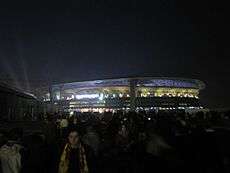 Aslanlı Yol
Aslanlı Yol Aslantepe Metro Station
Aslantepe Metro Station
References
- Ali Naci (2012-06-22). "Rekor ve gurur – Futbol Haberleri". Hurriyet.com.tr. Retrieved 2016-08-08.
- Turkish Football Federation
- "Archived copy". Archived from the original on 2014-10-11. Retrieved 2014-06-24.CS1 maint: archived copy as title (link)
- Federal Reserve Bank of Minneapolis. "Consumer Price Index (estimate) 1800–". Retrieved January 1, 2020.
- "Ali Sami Yen'de son teklifler alındı – 28 Mayıs 2010, Cuma". Objektifhaber.com. Retrieved 2016-08-08.
- "Archived copy". Archived from the original on 2011-07-11. Retrieved 2010-06-08.CS1 maint: archived copy as title (link)
- "'asp' Architekten Arat – Schust, Stuttgart". Asp-stuttgart.de. Retrieved 2016-08-08.
- "Türk Telekom Arena". V2.arkiv.com.tr. 2012-05-15. Archived from the original on 2016-09-23. Retrieved 2016-08-08.
- "OBERMEYER: Planungsgesellschaft". Opb.de. Retrieved 2016-08-08.
- "Türk Telekom Stadyumu". Retrieved 2018-03-14.
- http://www.tff.org/Default.aspx?pageID=394&stadID=5018
- "Archived copy". Archived from the original on 2011-05-08. Retrieved 2011-05-23.CS1 maint: archived copy as title (link)
- Clancy, Tom (2012). Threat Vector. USA: Putnam Adult. pp. 15, 18. ISBN 0399160450.
- https://www.telegraph.co.uk/sport/football/competitions/champions-league/10510613/Galatasaray-1-Juventus-0-match-report.html
- "Ali Sami Yen Stadyumu Alternatif Projesi". DBArchitects.com.tr. Retrieved 2016-08-08.
- "Archived copy". Archived from the original on 2011-11-04. Retrieved 2011-11-09.CS1 maint: archived copy as title (link)
- "TOKÄ° Seyrantepe Projesi'ni iptal etti – Futbol Haberleri". Hurriyet.com.tr. 2009-02-07. Retrieved 2016-08-08.
- "Varyap-Uzunlar Seyrantepe'de öne çıktı!". Emlakkulisi.Com. Retrieved 2016-08-08.
- Dilek Taş, "Seyrantepe'nin çatısını Galatasaray kapatacak", Sabah, 23 July 2010.
- "Pegasus Hava Yolları – Ucuz Uçak Bileti Demek Özgürlük Demek | Pegasus Hava Yolları". Flypgs.com. Archived from the original on 2010-12-29. Retrieved 2016-08-08.
- "FCN Blog: Pegasus Aslantepe'ye sponsor oldu". Fossacimbom.blogspot.com. Retrieved 2016-08-08.
- "Welcome gsdenizclub.com - BlueHost.com". Gsdenizclub.com. Archived from the original on 2016-08-21. Retrieved 2016-08-08.
- "Opel Now Also Galatasaray Istanbul Partner". OPEL. Retrieved 17 April 2013.
- "Archived copy". Archived from the original on 2013-01-29. Retrieved 2013-04-17.CS1 maint: archived copy as title (link)
- "Archived copy". Archived from the original on 2013-11-02. Retrieved 2013-10-31.CS1 maint: archived copy as title (link)
- "Opel'den 3.5 yıl için 5.6 milyon". Skorer.milliyet.com.tr. 2012-12-18. Retrieved 2016-08-08.
- "Archived copy". Archived from the original on 2013-11-01. Retrieved 2013-10-30.CS1 maint: archived copy as title (link)
- "KAP". KAP.gov.tr. 2013-10-31. Retrieved 2016-08-08.
- "TĂźrk Telekom Arena UEFA 5 STADYUM HAKKINDA". turktelekomstadyumu.com. Retrieved 2017-11-05.
- "TĂźrk Telekom Arena UEFA 5 YÄąldÄąz Stadyum Listesinde". Istanbul-rehber.com. Retrieved 2016-08-08.
- "Santiago Bernabéu Stadium | Real Madrid CF". Realmadrid.com. Retrieved 2016-08-08.
- "Twitter account of SIS worker Ivo Lamot". twitter.com. Retrieved 2018-01-16.
- "Archived copy". Archived from the original on 2012-07-07. Retrieved 2011-06-06.CS1 maint: archived copy as title (link)
- "Archived copy". Archived from the original on 2012-04-27. Retrieved 2012-05-25.CS1 maint: archived copy as title (link)
- "Türk Telekom Stadium GS Store". V2.arkiv.com.tr. 2012-05-15. Archived from the original on 2016-09-20. Retrieved 2016-08-08.
- "Archived copy". Archived from the original on 2011-03-03. Retrieved 2011-06-02.CS1 maint: archived copy as title (link)
- "GS Bonus | Kredi Kartı | Garanti Bonus". Bonus.com.tr. Retrieved 2016-08-08.
- "Archived copy". Archived from the original on 2010-07-27. Retrieved 2010-05-23.CS1 maint: archived copy as title (link)
- "GS Bonus Card bir ilke imza atıyor". NTVSpor.net. Retrieved 2016-08-08.
- "Ali Sami Yen Sports Complex is becoming a cash-free stadium through fastPay" (PDF). Denizbank.com. Retrieved 2019-03-12.
- "Guinness World Records". Guinnessworldrecords.de. Retrieved 2016-08-08.
- "Archived copy". Archived from the original on 2011-03-20. Retrieved 2011-03-20.CS1 maint: archived copy as title (link)
- "Archived copy". Archived from the original on 2012-09-26. Retrieved 2011-03-22.CS1 maint: archived copy as title (link)
- Kreamer, Matt (2013-09-15). "CenturyLink is Guinness World Record's loudest stadium | The Today File | Seattle Times". Blogs.seattletimes.com. Retrieved 2016-08-08.
- Kaduk, Kevin (13 October 2013). "Arrowhead Stadium sets loudest crowd record after Chiefs fans hit 137.5 decibels". Yahoo! Sports. Retrieved 13 October 2013.
- Frank Schwab (2013-12-03). "Seahawks take back the Guinness World Record for crowd noise at 137.6 decibels". Sports.yahoo.com. Retrieved 2016-08-08.
- "It's official! 142.2 is a new Guinness World Record". facebook.com. Kansas City Chiefs. Retrieved 30 September 2014.
- Tyler Brooke. "Kansas City Chiefs Break Seattle Seahawks' Record of Loudest Outdoor Stadium". Bleacher Report. Retrieved 2016-08-08.
- "Turkey vs. Estonia – 10 August 2011 – Soccerway". Int.soccerway.com. 2011-08-10. Retrieved 2016-08-08.
- "Turkey vs. Kazakhstan – 2 September 2011 – Soccerway". Int.soccerway.com. 2011-09-02. Retrieved 2016-08-08.
- "Turkey vs. Germany – 7 October 2011 – Soccerway". Int.soccerway.com. 2011-10-07. Retrieved 2016-08-08.
- "Turkey vs. Azerbaijan – 11 October 2011 – Soccerway". Int.soccerway.com. 2011-10-11. Retrieved 2016-08-08.
- "Turkey vs. Croatia – 11 November 2011 – Soccerway". Int.soccerway.com. 2011-11-11. Retrieved 2016-08-08.
- "Turkey vs. Denmark – 14 November 2012 – Soccerway". Int.soccerway.com. 2012-11-14. Retrieved 2016-08-08.
- "Turkey vs. Kazakhstan – 16 November 2014 – Soccerway". Int.soccerway.com. 2014-11-16. Retrieved 2016-08-08.
- "Turkey vs. Iceland – 14 November 2019 – Soccerway". Int.soccerway.com. 2019-11-14. Retrieved 2019-11-14.
- "FIFA U20 Dünya Kupası biletleri satışa çıktı" (in Turkish). Turkish FootballFederation. 2012-12-01. Retrieved 2012-11-30.
- "FIFA U-20 World Cup Turkey 2013 – Matches – France-Ghana". FIFA.com. 2016-07-23. Retrieved 2016-08-08.
- "FIFA U-20 World Cup Turkey 2013 – Matches – USA-Spain". FIFA.com. 2016-07-23. Retrieved 2016-08-08.
- "FIFA U-20 World Cup Turkey 2013 – Matches – France-USA". FIFA.com. 2016-07-23. Retrieved 2016-08-08.
- "FIFA U-20 World Cup Turkey 2013 – Matches – Spain-Ghana". FIFA.com. 2016-07-23. Retrieved 2016-08-08.
- "FIFA U-20 World Cup Turkey 2013 – Matches – Spain-France". FIFA.com. 2016-07-23. Retrieved 2016-08-08.
- "FIFA U-20 World Cup Turkey 2013 – Matches – Korea Republic-Nigeria". FIFA.com. 2016-07-23. Retrieved 2016-08-08.
- "FIFA U-20 World Cup Turkey 2013 – Matches – Spain-Mexico". FIFA.com. 2016-07-23. Retrieved 2016-08-08.
- "FIFA U-20 World Cup Turkey 2013 – Matches – Nigeria-Uruguay". FIFA.com. 2016-07-23. Retrieved 2016-08-08.
- "FIFA U-20 World Cup Turkey 2013 – Matches – Ghana-Chile". FIFA.com. 2016-07-23. Retrieved 2016-08-08.
- "FIFA U-20 World Cup Turkey 2013 – Matches – Ghana-Iraq". FIFA.com. 2016-07-23. Retrieved 2016-08-08.
- "FIFA U-20 World Cup Turkey 2013 – Matches – France-Uruguay". FIFA.com. 2016-07-23. Retrieved 2016-08-08.
- "Archived copy". Archived from the original on 2013-01-25. Retrieved 2013-03-05.CS1 maint: archived copy as title (link)
- "Galatasaray'dan kombine rekoru!". Skorer.milliyet.com.tr. 2013-03-30. Retrieved 2016-08-08.
- "Galatasaray yeni rekorun peşinde!". Posta.com/tr. Retrieved 2016-08-08.
- "Galatasaray'dan tarihi rekor". asistanaliz.com. 2019-09-11. Retrieved 2019-09-11.
- "Galatasaray'dan tarihi rekor". asistanaliz.com. 2019-09-11. Retrieved 2019-09-11.
- "Galatasaray'dan tarihi rekor". asistanaliz.com. 2019-09-11. Retrieved 2019-09-11.
- "Galatasaray'dan tarihi rekor". asistanaliz.com. 2019-09-11. Retrieved 2019-09-11.
- "Galatasaray'dan tarihi rekor". asistanaliz.com. 2019-09-11. Retrieved 2019-09-11.
- "Galatasaray'dan tarihi rekor". asistanaliz.com. 2019-09-11. Retrieved 2019-09-11.
- "Galatasaray'dan rekor gelir". Aksam.com.tr. Retrieved 2016-08-08.
External links
| Wikimedia Commons has media related to Türk Telekom Arena. |
- (in English) Club information on new stadium
- (in Turkish) Türk Telekom Stadium Official WebSite
- (in Turkish) Türk Telekom Stadium Official Ticket WebSite
- Türk Telekom Stadium on Wikimapia
- Design of stadium
| Preceded by Estadio Nemesio Camacho Bogotá |
FIFA U-20 World Cup Final Venue 2013 |
Succeeded by North Harbour Stadium Auckland |

